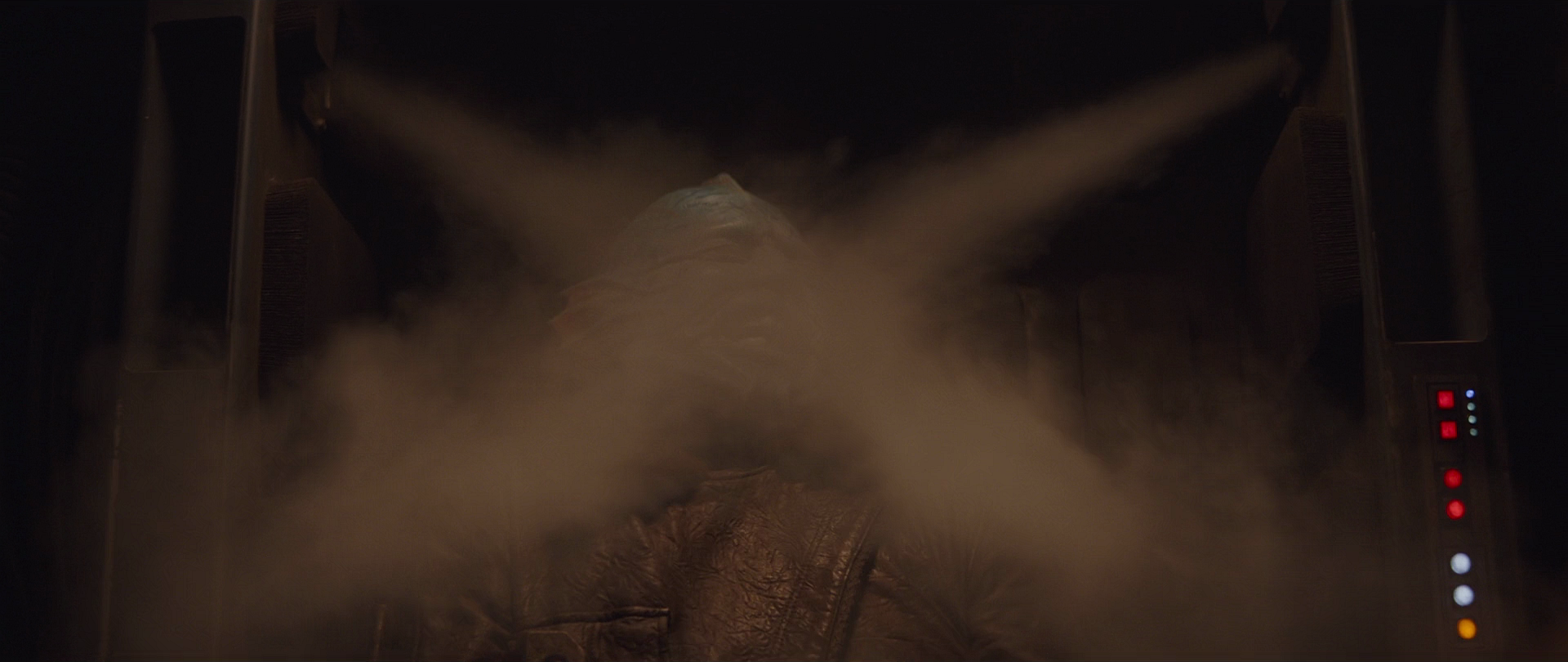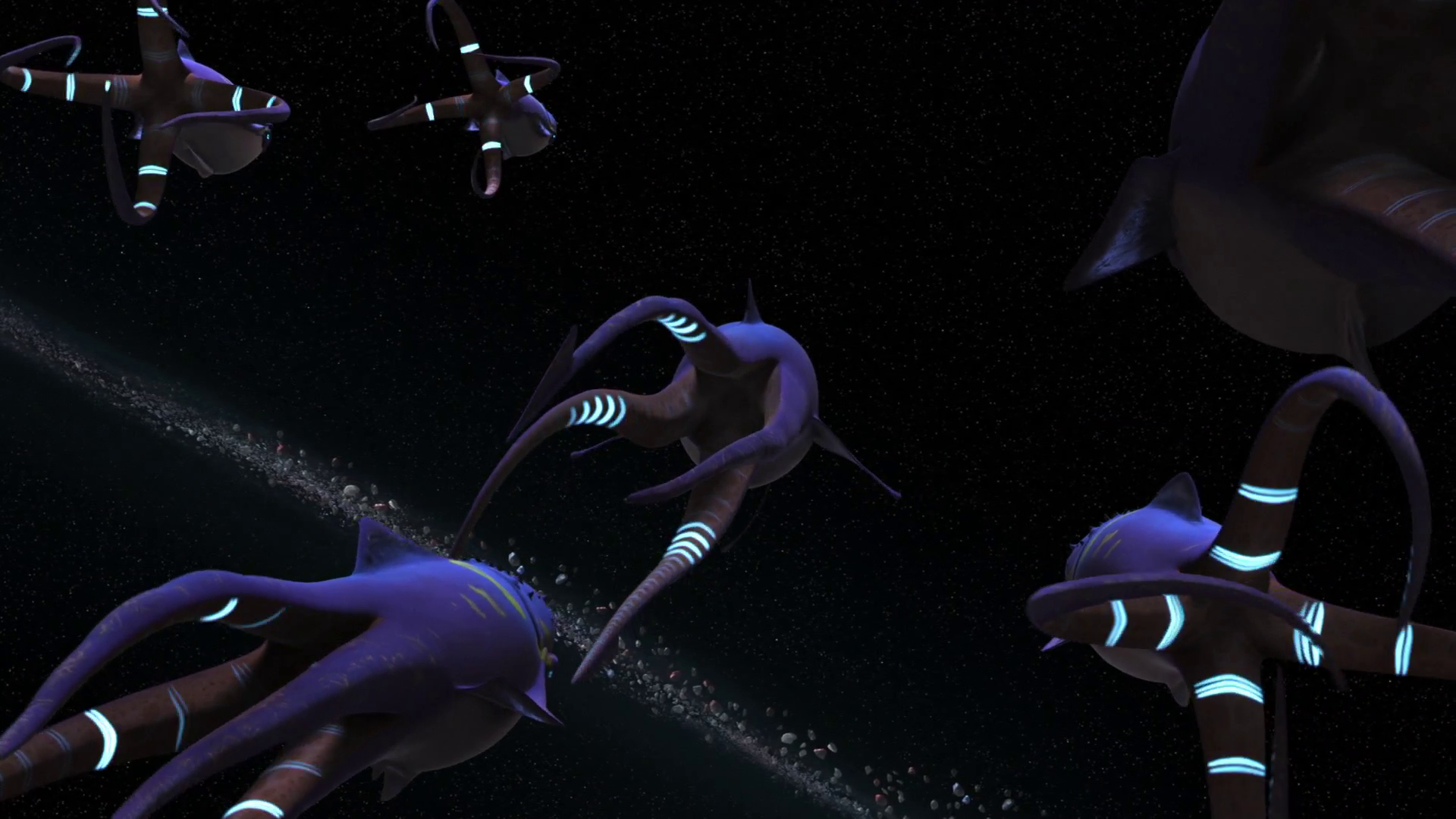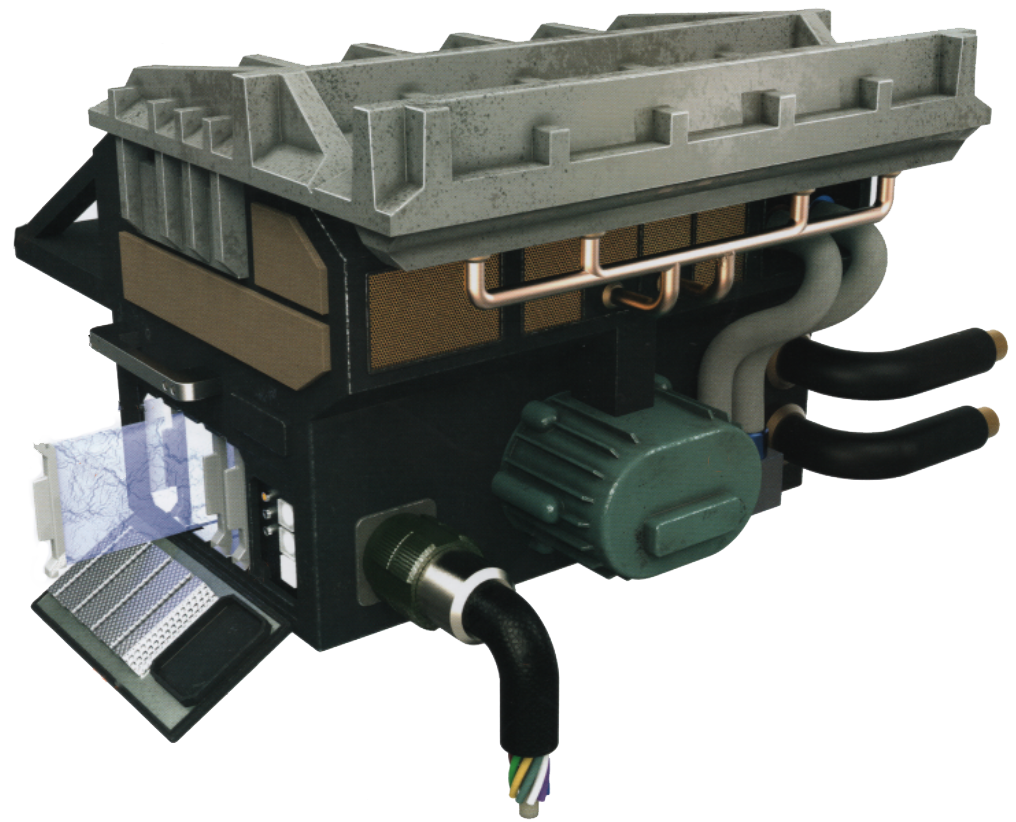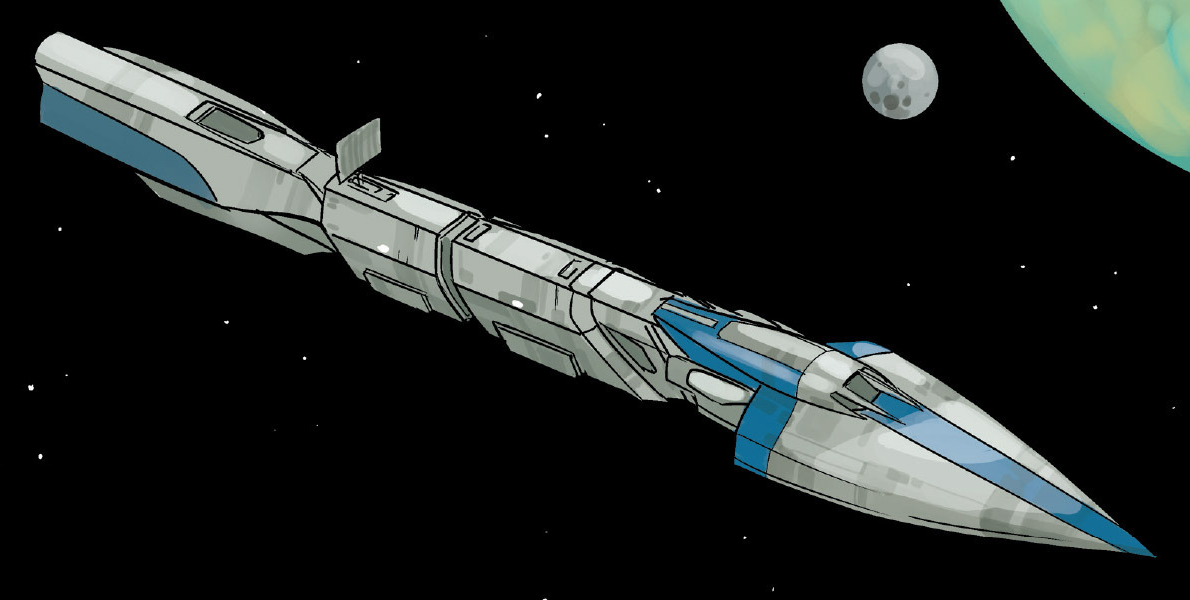The hyperdrive was a propulsion system that allowed a starship to reach lightspeed and traverse the void between stars in the alternate dimension of hyperspace. As a consequence, the hyperdrive was a key instrument in shaping galactic society, trade, politics, and war.
The hyperdrive required a functional hyperdrive motivator to operate. The vessel then traveled along a programmed course until it dropped back into normal space—realspace—at its destination.
A hyperdrive only functioned to keep a vessel in hyperspace, and should a hyperdrive be forcibly deactivated or destroyed during transit, the ship was violently and instantly pulled back into realspace.
Being short-range craft, most starfighters lacked a hyperdrive. This was notably the case with the Galactic Empire's TIE fighters, which had to be ferried to combat zones aboard larger ships. However, the X-wing and A-wing starfighters used by the Rebel Alliance were fitted with hyperdrives, allowing them to make long-range jumps.
Upon entering hyperspace, a ship emitted cronau radiation, which was possible to detect with specialized sensor suites.
Large objects in normal space cast "mass shadows" in hyperspace, thus hyperspace jumps required accurate plotting to avoid collisions, which were often fatal.
Later technologies could pull vessels out of hyperspace. For instance, interdiction fields created gravitational shadows, simulating mass, in the path of an oncoming vessel, yanking the vessel out of hyperspace. Imperial technologists developed the widely used Interdictor vessels and their various sub-models, some of the most effective interdiction technologies.

A Mythrol being frozen in carbonite in an advanced mini freezing station
In the ancient times, due to the lack of hyperdrive technologies the earliest spacers used generation ships to travel through the galaxy and traverse the vast distances from one planet to another. Most notable for being used by a patriarch of the Coruscanti to blaze the Koros Trunk Line, generation ships were soon replaced by sleeper ships following the invention of carbonite by the scientists on the planet Koros Major. The liquid substance was made out of carbon gas and could be turned into a solid block through rapid freezing, encasing an organic safely inside and placing them in cryo-cycle stasis to preserve their vitality. The process, known as carbon-freezing ushered in a new era of space exploration and inadvertently helped the formation of the Galactic Republic as the people of the galaxy came closer together. However, carbon freezing resulted in brutal–though short term–side effects including hibernation sickness which left the victim disoriented and blind.

Purrgil's use of simu-tunnels provided researchers with a clue on solving the space travel problem
While practical, neither generation nor sleeper ships were actually efficient for long-term commercial or civilian use, leading scientists to research for an alternative mode of interplanetary transportation. Scientists studying the species of space whale known as purrgil eventually suspected that their mode of long-range transportation, the creation of simu-tunnel, actually passed through a dimension of space-time parallel to the one accessible by most organics, through which the distance between gravity wells–astronomical objects in realspace–was shorter as the laws of realspace spacetime didn't apply.
By studying the behavior of purrgil, scientists discovered that hyperspace could be accessed by molecular displacement, which could only be achieved by breaking the speed of light. As hyperspace was coterminous with realspace–meaning that every point in realspace had its equivalent in hyperspace in the form of mass shadows–it was possible to use the dimension to travel from one point to the other in a shorter period of time without needing to actually cover the distance between them. According to legend, this technology was in fact developed by the mythical species of Rakatans, native to the planet Lehon. Developing hyperdrive technology on the planet Devaron independently from extraterrestrial assistance, the Devaronians had explored and interacted with the galaxy before the Galactic Republic ever made contact with their region of space. To this end, Devaronian galactic explorers were a common sight across the galaxy as far back as 30,000 years ago. As early as 27,000 BBY, the Gossam Courivers reached the planet Felucia with the use of a tumbledrive propulsion engine. Eventually, Corellian engineers independently from their Duros counterparts developed the technology necessary to access the dimension, and dubbed it the hyperdrive–in contrast with standard engines, which were named sublight engines.

Republic Pathfinder teams explored new worlds and blazed hyperlanes during the Great Hyperspace Rush
Once hyperdrives made faster-than-light travel possible, galactic civilization flourished throughout ancient history. The Old Republic sent pioneering scout ships to explore the galaxy as increasing numbers of civilians from the Core Worlds sought a better life. The Devaronians were among the early explorers along what became the Corellian Trade Spine hyperspace route. Early hyperdrive routes were blazed by scouts such as the San Tekka clan by using hyperspace sextants or simply following purrgil in their travels. The latter practice demonstrated the species' tendency to feed on the gas Clouzon-36, which formed in places subject to intense interstellar energy, like Kessel or the Redhurne system. Knowledge of this practice led humans to discover the mineral coaxium which also formed in the same places and like Clouzon fuel faster and better hyperdrive jumps. Unfortunately, the faster-than-light travel also created new possibilites for war, as the now-mythological Great Hyperspace War between the Republic and Sith Empire proved just over 5,000 years ago.
Prospectors and explorers started using the primitive hyperspace paths and the advanced hyperdrives of the time to explore the vastness of space, ushering in the Great Hyperspace Rush. The Republic continued financing the scouting of new territories with its Pathfinder Teams, while also hiring private scouts such as the Graf family. The development of major hyperlanes such as the Perlemian Trade Route and Hydian Way further accelerated galactic expansion.
Hyperdrives consisted of two basic parts: a navigation computer and the actual reactor assembly–also known as the hyperdrive generator. The navicomputer calculated a safe path through hyperspace by comparing the pilot's desired path with known hyperlanes and dangers already present along the way such as supernovas and asteroid fields to ensure a safe journey, while the reactor handled the work of generating enough power to perform a jump without straining the ship's main reactor.

An R-300H hyperdrive motivator, used in BLT-A4 Y-wing bombers in the place of a reactor
Most modern hyperdrive reactors had a main chamber coated in coaxium, which significanty improved their efficiency. Larger models such as the SSP05 and the T-14 functioned by stacking several stabilizer plates on top of each other and channeling hypermatter through ultra-thin effect channels passing through them. Hypermatter, whose energy output was controlled by the navicomputer, reached the ship's main engines and charged the ions already present there, powering them for the jump to lightspeed; a hyperdrive motivator controlled the jump based on sensor output and ensured a risk-free trip and return to realspace. Smaller ships such as starfighters or bombers ditched the hyperdrive reactor altogether and instead relied only on the motivator, with power provided by the ship's standard reactor. Examples of standalone motivators were the R300-H hyperdrive motivator of the BTL-A4 Y-wing starfighter and the GBk-585 hyperdrive motivator of the T-65B X-wing starfighter.
During the Clone Wars, a microjump was used to rescue Jedi Master Eeth Koth from the forces of the Confederacy of Independent Systems in orbit of Saleucami. Using the exact coordinates of General Grievous' command ship, Anakin Skywalker precisely jumped through hyperspace, arriving meters away from his target, undetected. The same precise jumping technique was used by Han Solo to infiltrate the First Order superweapon Starkiller Base, since the planet's shields were using a fractional refresh rate that would keep anything below light speed from passing through. Without careful planning, using the hyperdrive in such a manner could result in the loss of a ship due to the nature of mass shadows, but the most gifted pilots like Solo and Skywalker could use those characteristics of space to their advantage.

Vice Admiral Amilyn Holdo used a directed hyperspace jump to ram and cripple the dreadnought Supremacy.
In 34 ABY, Resistance Vice Admiral Amilyn Holdo executed a hyperspace jump with the cruiser Raddus that was directly aimed at the First Order flagship Supremacy, causing the enemy ship to be sliced apart in the resulting collision.

The Carrion Spike had a Class 1 rating; as such it was the fastest ship officially assigned to the Imperial Navy
Hyperdrives were rated by "class": the lower the class, the faster the engine. Most civilian ships used hyperdrives rated Class Three or higher, while government, diplomatic, and military ships were equipped with Class Two or Class One hyperdrives. With its Class One hyperdrive, the Carrion Spike was the fastest ship in the Imperial Navy, while top-of-the-line capital ships such as the Imperial I-class Star Destroyer featured Class 2 hyperdrives. The First Death Star, meanwhile, had a mere Class 4 hyperdrive. The T-14 hyperdrive generator equipped on J-type 327 Nubian starships was rated Class 1.8. Some ships, such as Nakari Kelen's Desert Jewel or Han Solo's Millennium Falcon, had exceptionally fast hyperdrives—Class 0.8 and 0.5 respectively.
- Star Wars: Visions — "THE TWINS"
- LEGO Star Wars: Build Your Own Adventure